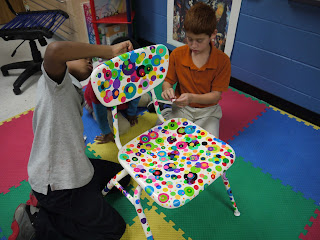This past semester, I was fortunate to host a student teacher from Lipscomb University. Lauren Hundley was in the Master's Program and did an amazing job while at Shayne! The students and I enjoyed having her teach and we both learned from her knowledge and creativity!!!
Lauren taught our first graders about the Russian artist Wassily Kandinsky. She introduced the lesson with a book entitled The Noisy Paint Box. Students learned about Kandinsky's art and love of music. Kandinsky could "hear color"as he painted.
Kandinsky is believed to have had synaesthesia, a harmless condition that allows a person to appreciate sounds, colors or words with two or more senses simultaneously. In his case, colors and painted marks triggered particular sounds or musical notes and vice versa. The involuntary ability to hear color, see music or even taste words happens from an accidental cross-wiring in the brain that is only found in one out of 2,000 people.
Next Kindergartners chose felt shapes from a box and created a Kandinsky-esque artwork. As each student placed a shape on the felt board, the rest of the class drew the shape on their paper with construction paper crayons.
 Finally, students used water colors and painted the background in the style of Kandinsky! We had a great time learning about Abstract Art! LINE, SHAPE, and COLOR!!!
Finally, students used water colors and painted the background in the style of Kandinsky! We had a great time learning about Abstract Art! LINE, SHAPE, and COLOR!!!















































